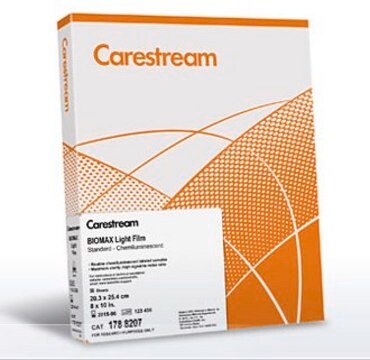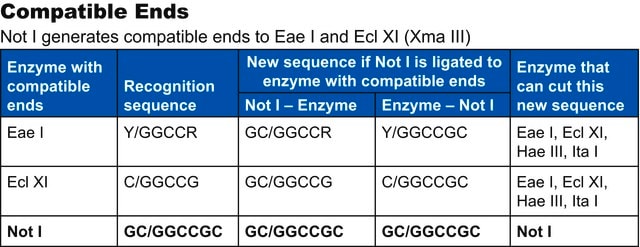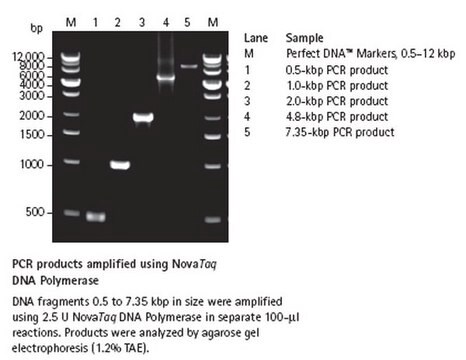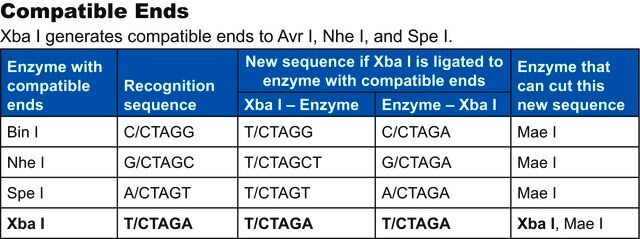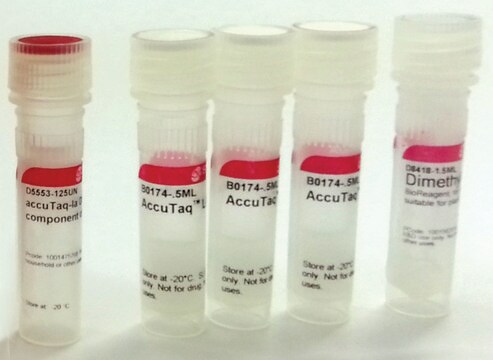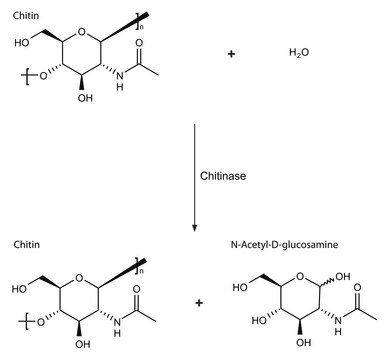Wszystkie zdjęcia(1)
Kluczowe dokumenty
R0260
BamH I from Bacillus amyloliquefaciens H
Restriction Enzyme
Zaloguj sięWyświetlanie cen organizacyjnych i kontraktowych
About This Item
Numer CAS:
Numer MDL:
Kod UNSPSC:
12352204
Polecane produkty
klasa czystości
Molecular Biology
for molecular biology
Formularz
buffered aqueous glycerol solution
stężenie
10,000 units/mL
Warunki transportu
wet ice
temp. przechowywania
−20°C
Szukasz podobnych produktów? Odwiedź Przewodnik dotyczący porównywania produktów
Specyficzność
Recognition sequence: 5′-G/GATCC-3′
Cutting results: a 2-10-fold Bam HI overdigestion of 1 μg λ DNA substrate results in 100% cutting
Heat inactivation: 60 °C for 15 minutes.
Star activity: To prevent star activity, avoid suboptimal reaction conditions containing low salt concentration, high glycerol (>5%) and high pH 8.0.
Cutting results: a 2-10-fold Bam HI overdigestion of 1 μg λ DNA substrate results in 100% cutting
Heat inactivation: 60 °C for 15 minutes.
Star activity: To prevent star activity, avoid suboptimal reaction conditions containing low salt concentration, high glycerol (>5%) and high pH 8.0.
Zastosowanie
BamHI is a DNA restriction endonuclease that is used in molecular biology applications to cleave DNA at the recognition sequence 5′-G/GATCC-3′ to generate 5′-cohesive termini.
Inne uwagi
Supplied with 10x Restriction Enzyme Buffer SB (B8781).
Postać fizyczna
Solution in 10 mM Tris-HCl, pH 7.4 , 1 mM EDTA, 1mM dithioerythritol, 300 mM KCl, 0.01% Polydocanol (v/v), 50% glycerol (v/v), at 4°C
Ta strona może zawierać tekst przetłumaczony maszynowo.
bufor inkubacyjny
Numer produktu
Opis
Cennik
produkt powiązany
Kod klasy składowania
12 - Non Combustible Liquids
Klasa zagrożenia wodnego (WGK)
WGK 1
Temperatura zapłonu (°F)
Not applicable
Temperatura zapłonu (°C)
Not applicable
Wybierz jedną z najnowszych wersji:
Masz już ten produkt?
Dokumenty związane z niedawno zakupionymi produktami zostały zamieszczone w Bibliotece dokumentów.
J H Ellis et al.
Journal of immunology (Baltimore, Md. : 1950), 156(8), 2700-2709 (1996-04-15)
CD80 and CD86 are cell surface glycoproteins expressed on a variety of professional APCs. They have attracted much attention due to their function as potent costimulators of T lymphocyte function through their interaction with CD28 and possibly CTLA4. Because inhibitors
Isolation of a sequence-specific endonuclease (BamI) from Bacillus amyloliquefaciens H.
G A Wilson et al.
Journal of molecular biology, 97(1), 123-125 (1975-09-05)
P Manivasakam et al.
Nucleic acids research, 29(23), 4826-4833 (2001-12-01)
Mammalian cells repair DNA double-strand breaks by illegitimate end-joining or by homologous recombination. We investigated the effects of restriction enzymes on illegitimate and homologous DNA integration in mammalian cells. A plasmid containing the neo(R) expression cassette, which confers G418 resistance
C Kessler et al.
Gene, 92(1-2), 1-248 (1990-08-16)
The properties and sources of all known class-I, class-II and class-III restriction endonucleases (ENases) and DNA modification methyltransferases (MTases) are listed and newly subclassified according to their sequence specificity. In addition, the enzymes are distinguished in a novel manner according
Cong Zhu et al.
Nucleic acids research, 41(4), 2455-2465 (2013-01-11)
Zinc-finger nucleases (ZFNs) have been used for genome engineering in a wide variety of organisms; however, it remains challenging to design effective ZFNs for many genomic sequences using publicly available zinc-finger modules. This limitation is in part because of potential
Nasz zespół naukowców ma doświadczenie we wszystkich obszarach badań, w tym w naukach przyrodniczych, materiałoznawstwie, syntezie chemicznej, chromatografii, analityce i wielu innych dziedzinach.
Skontaktuj się z zespołem ds. pomocy technicznej
